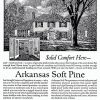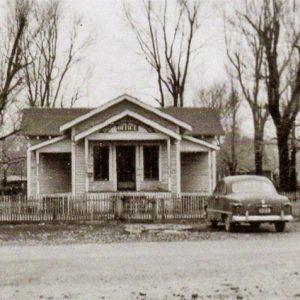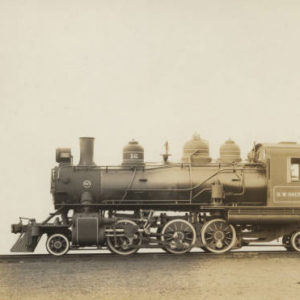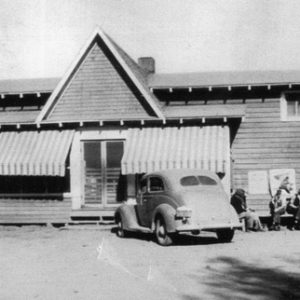calsfoundation@cals.org
Caddo River Lumber Company
Caddo River Lumber Company was one of the largest lumber companies operating in the Ouachita Mountains during the first half of the twentieth century. During the Depression, it may have been the largest manufacturing employer in the state. However, like many other lumber companies of the era, it succumbed to a shortsighted policy of non-sustainable practices.
The Caddo River Lumber Company was organized in 1906 by Thomas Whitaker Rosborough, M. R. Smith, W. E. Cooper, and Lee Wilson of Kansas City, Missouri, with Smith as president and Rosborough as vice president, though the latter managed the operations of the company. Rosborough had previously operated sawmills and a planing mill in Arkansas and Louisiana and had done some work for Ozan Lumber Company, which was established by some relatives of his sister’s husband. Obtaining backing from his Kansas City partners, he sought to establish a sawmill along the Gurdon and Fort Smith Railroad, settling on a site in Pike County he named Rosboro after himself, though with a simplified spelling. The sawmill was in place by 1907. He proceeded to purchase land from his in-laws in the Ozan Lumber Company and later purchased more land from Dierks Lumber and Coal Company. The company built a number of railroad spurs into the land it owned for the easy transportation of logs but soon chartered the Caddo and Choctaw Railroad Company, which carried passengers and freight in addition to timber. However, the railroad was never completed all the way to Fort Smith (Sebastian County), as had been planned, but rather stopped at the town of Norman (Montgomery County).
In 1915, the sawmill at Rosboro burned; it was soon rebuilt at double capacity. In 1918, the company acquired 30,000 acres in the Montgomery County area from Graham Lumber Company of St. Louis, Missouri; other acquisitions soon followed, and Caddo River Lumber Company eventually owned timberland and cutting rights across most of northern Montgomery County. The company established a site four miles from Mount Ida (Montgomery County), named Mauldin, to serve as a logging center; after track was laid to Mauldin in 1922, it became a regular logging town. That same year, the company purchased the Glenwood (Pike County) sawmill, town lots, and other buildings from the A. L. Clark Lumber Company. With two double-band mills and large holdings in Montgomery County, Caddo River Lumber Company emerged as the second largest in the Ouachita Mountain area, behind only Dierks.
Rosborough was at ease with African Americans and employed quite a few, but this attitude frequently brought him into conflict with locals, given that many communities in the Ouachita Mountains were “sundown towns”—places where African Americans were forbidden by white residents from living, usually through the threat of violence. At the very beginning of the Caddo River Lumber Company’s operation, Rosborough sought to buy land for a sawmill at Amity (Clark County), but local residents balked at the idea of black people entering their town, and so he chose the site that became Rosboro. Would-be whitecappers once distributed leaflets around Rosboro warning African Americans to leave, to which Rosborough responded by arming his black mill workers for their self-protection. He also installed a high board fence around the black quarters until the threats died down. Waldron (Scott County) and Mount Ida also turned down offers from Rosborough to build sawmills there due to his employment of black workers. Rosborough also experienced difficulties keeping black workers at Mauldin due to local antipathy.
In 1924, M. R. Smith sold his share in the company to Kansas City lumberman William F. Ingham. By the middle of the decade, through purchases both large and small, Caddo River Lumber Company reached into Yell and Scott counties. However, the company greatly limited much of its future profitability by not initiating a sustainability program and selling much of its cutover land to Dierks, which was then planting said land with the expectation of harvesting second-growth trees. By the early 1930s, Dierks and Caddo River were the only lumber companies operating in the Ouachita Mountains. Caddo River established a new sawmill in Scott County at a site named Forester, about twenty miles southeast of Waldron. This expansion drained company resources at a time when the Depression was already hitting hard, though Caddo River managed to maintain a payroll of more than 1,000 people.
In 1936, a disastrous fire in Glenwood burned the sheds and a planing mill there, and they were not rebuilt. The following year, the company finished removing timber in Montgomery County and dismantled the site at Mauldin. At the end of 1937, the Glenwood sawmill was shut down and sold, though after a 1938 fire at Forester destroyed that mill, the company bought it back and transferred it. The expansion of the Ouachita National Forest during this decade allowed Caddo River to sell approximately 200,000 acres of cutover land. Very few people in the company’s leadership were interested in pursuing operations on cutover land, even though Dierks’s sustainability program was demonstrating promise; Dierks also had a policy of converting wood waste into boiler fuel or other products rather than simply burning it. In 1939, the sawmill at Rosboro closed, and some of the equipment was transferred to Oregon, where Rosborough had recently purchased land and established a sawmill. Rosborough sold his interest in the company to Hal Shaffer, who became president. At the time, Caddo River’s only mill was at Forester. On July 17, 1945, Shaffer sold Caddo River’s operations, land, and cutting rights to Dierks Lumber and Coal Company.
For additional information:
Balogh, George W. Entrepreneurs in the Lumber Industry: Arkansas, 1881–1963. New York: Garland Publishing, Inc., 1995.
Smith, Kenneth L. Sawmill: The Story of Cutting the Last Great Virgin Forest East of the Rockies. Fayetteville: University of Arkansas Press, 1986.
Staff of the CALS Encyclopedia of Arkansas
 Arkansas Soft Pine Bureau (ASPB)
Arkansas Soft Pine Bureau (ASPB) Business, Commerce, and Industry
Business, Commerce, and Industry Early Twentieth Century, 1901 through 1940
Early Twentieth Century, 1901 through 1940 Night Riders
Night Riders Caddo River Lumber Company
Caddo River Lumber Company  Caddo River Lumber Company
Caddo River Lumber Company  Company Locomotive
Company Locomotive  Forester Reunion Park
Forester Reunion Park  Forester Company Store
Forester Company Store  Forester Logging
Forester Logging 




Comments
No comments on this entry yet.